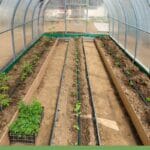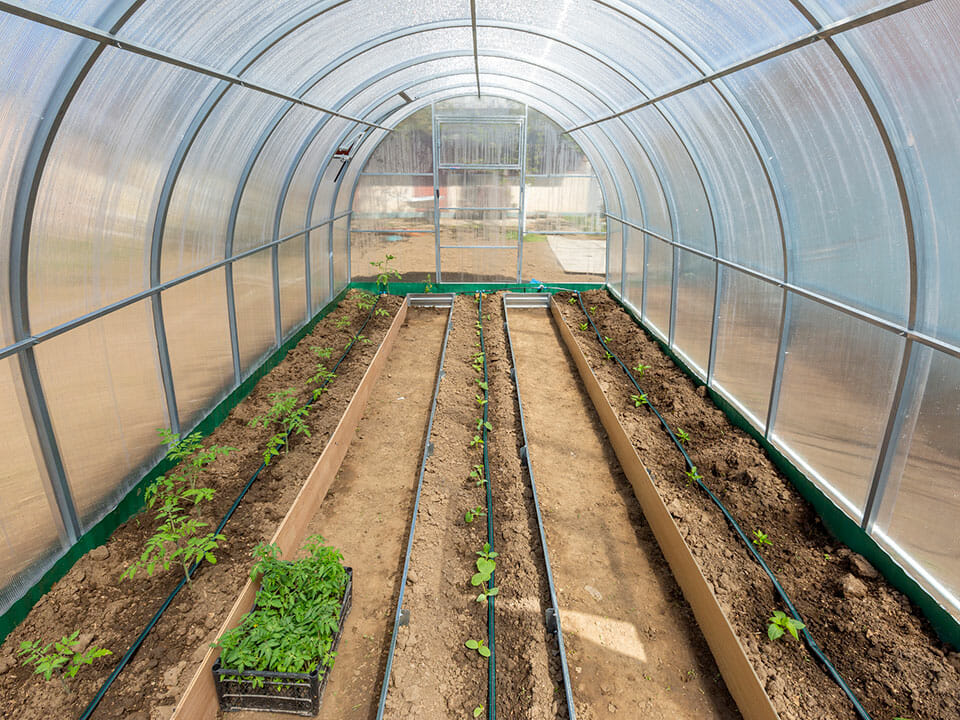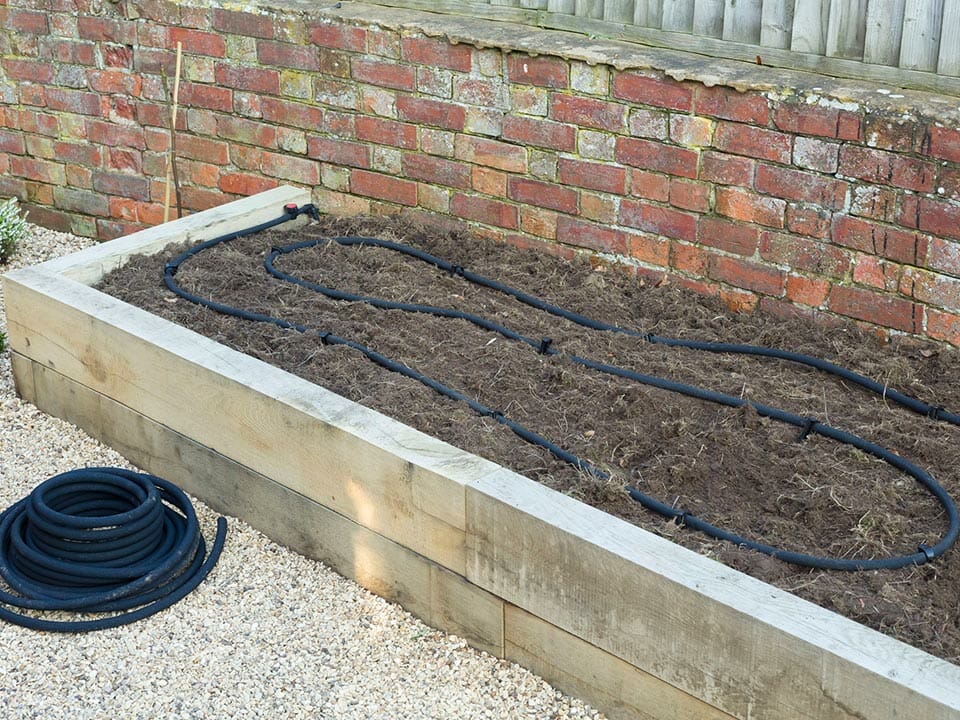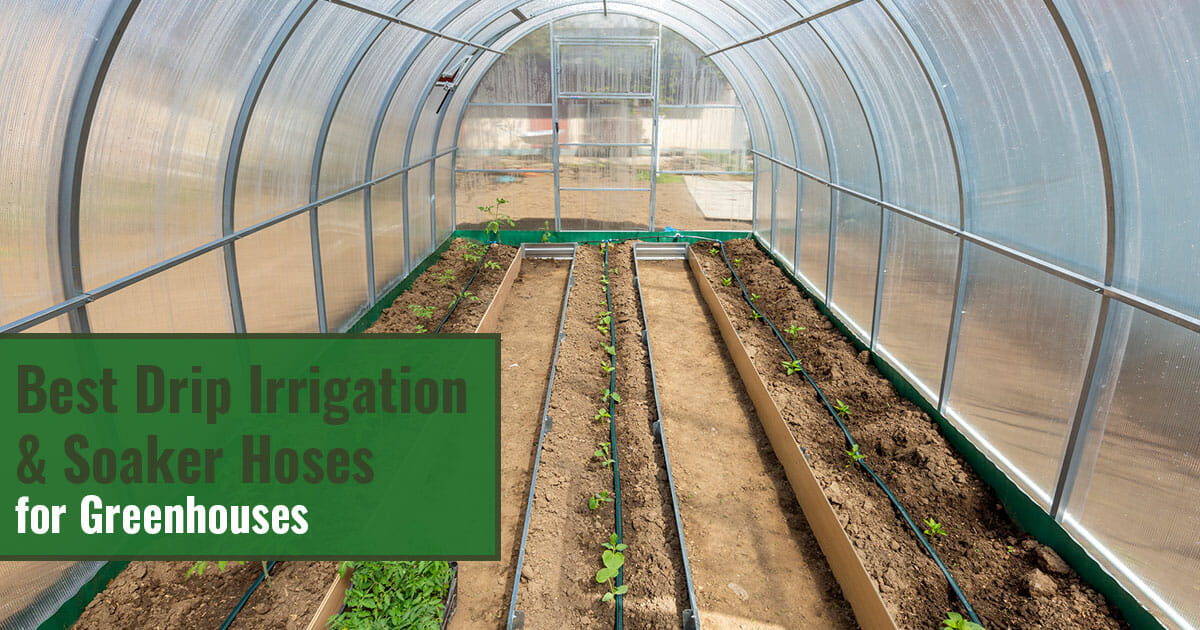

If you are tired of losing your plants and vegetables from a lack of watering in your garden or greenhouse, then it’s time to get an effective watering system. Just any won’t do though. You’ll need an automatic system that’ll help you save water, time, and get the job done accurately.
Thorough research will reveal two great options – drip irrigation systems and soaker hoses for greenhouses Both watering methods are by far better than sprinkler irrigation in terms of water management and precision. While they seep water to the soil and perform similar functions, these methods offer you more control.
How do you know which is the best option for you? That’s what this article is about. We want to help you figure out the perfect system that’ll suit your watering needs. Let’s begin by talking about both of them briefly.
What is a drip irrigation system?
Drip irrigation is a top-notch choice for professional growers. It is a watering system that consists of emitters and tubes that provide your plants with a sufficient amount of water. There’s usually a long tube connecting other small tubes and/or nozzles that deliver water directly to the roots of your plants.
In most cases, the major water line is connected to a tap with a pressure regulator, filter, valve, and backflow. This makes it a bit more expensive. The drip irrigation system delivers accurate precision as it’s possible to adjust the system to the shape and size of your greenhouse.
There are two types of drip irrigation systems to suit different garden and greenhouse types – drip tape and drip line. While the drip tape comes in a flat style that requires a pressure reducer in the waterline, the drip line uses a round tubing with heavy-duty plastic that performs well for various seasons.

Pros
- Drip irrigation systems provide effective and precise water distribution. This system drips water slowly and steadily, so you can be sure that water will get deep into the root area.
- Drip systems give room for easy customization. They are a versatile option that allows you to customize your watering system to suit your garden soil, shape, and size. You can install and configure pressure-compensating emitters to focus on certain parts of your garden.
- These systems are easier to repair. They don’t require any technical tools and replacement parts are easy to find.
- Drip irrigation systems perform well on timers.
- They are perfect for large greenhouses and gardens or long runtimes.
- These systems can last up to 20 years.
Cons
- The drip irrigation system will need periodic maintenance as the emitters may get clogged overtime from mineral build up or hoses can become damaged from heat.
- This system must be disassembled at the end of the season and packed away for the next.
- Drip systems require a higher initial investment.
- They are not super easy to install. You’ll have to plan accordingly before getting it set up.
What are soaker hoses?
Soaker hoses are flexible and simple automatic watering systems mostly used by hobby gardeners. They are simply porous tubes that let water into the soil with many tiny holes. They are normally placed on the surface of the soil to provide water directly to the roots of your plants.
Soaker hoses come in different materials. Most of them are made of recycled rubber and polyethylene. Some other high-quality soaker hoses contain fiber reinforcement to ensure durability. There are two types of soaker hoses: flat and round.
Flat soaker hoses are perfect for watering straight rows of crops, as they have holes on just one side. While round hoses can be used on both straight rows and can be snaked around bushes and trees. They are also more durable and flexible.

Pros
- Soaker hoses deliver water at ground level. This keeps your foliage dry and less susceptible to fungal growth.
- Soaker hoses are relatively cheaper and easier to install when compared to the drip irrigation system.
- Clogging is not a problem with soaker hoses.
- Soaker hoses are great options for smaller greenhouses.
- This option does not need pressure regulators. You can simply adjust the water pressure by opening and closing the flow from the tap.
- They can last up to 4 years.
Cons
- Soaker hoses don’t work well on sloped ground.
- They are not as customizable as drip systems.
- Not as precise as drip systems.
- Soaker hoses can easily get damaged if they are not well taken care of.
- They are quite difficult to repair. For instance, if you puncture part of your soaker hose with a digging fork, you’ll need to cut out the damaged part and rejoin the two sides. This will make the hose much shorter so you might find yourself replacing it entirely.
Which automatic irrigation system should I use?
Making a decision on which of these two watering systems to use is very tricky. Both systems are similar and perform almost the same functions. They vary in terms of durability, cost, maintenance, and coverage area. Here, we’ll be taking a closer look at these factors so it’ll be much easier for you to make a choice.
Cost and durability
For drip irrigation systems, you’ll need to purchase emitters, filters, flow regulators. All of these items can make it quite costly. The soaker hoses require less initial investment since you don’t need to buy so many little parts.
If you have a slim budget, soaker hoses may be the best option for you. But if you are out for a more durable system, drip irrigation is the best pick. While drip systems require a larger initial investment, they’ll last you much longer than soaker hoses.
Watering precision
The drip irrigation system offers better watering precision. You can space the emitters out so they simply focus on the plants’ roots where you need them. Soaker hoses continually let water through. This means the soil will always be wet. Some plants may not like this.
When it comes to watering precision, the drip irrigation system is the better option when compared to soaker hoses.

Size and shape of the garden and greenhouse
The size and shape of your garden is another factor you’ll need to consider carefully. Most drip irrigation systems work well in both large and small gardens, as well as greenhouses.
Soaker hoses are not good options for uneven areas since they are not pressure-compensating. They also will not work well in large-sized gardens or greenhouses. They are a great option if you have a small or medium-sized garden or greenhouse with plants placed close to each other or in raised garden beds.
If you plan to use a lot of pots, trays, and smaller planters, drip irrigation is the better solution. If you are planning to use larger raised beds or planters, soaker systems may work better for you.
Ease of installation
No doubt, soaker hoses are much easier to install when compared to drip systems. All you need to do is to attach your soaker hose to your garden hose or faucet. But for drip irrigation systems, you will need to spend more time in planning.
Both systems are relatively easy to use. They are time-saving options that’ll help you spend less time and energy.
In the end…
It isn’t possible to say one system is better than the other. It all depends on your needs and preferences. Both systems have their benefits and downsides.
Soaker hoses are great options for you if you want a simple watering system that’s cheaper and easy to set up and use, they work well on raised beds too!
Drip irrigation systems are more versatile and suitable for large, uneven gardens and greenhouses.
If you are not using soaker hoses or drip systems in your garden, it’s time to switch to something more efficient. Their initial cost can be high, but with time you’ll cut costs on water bills and time. Drip irrigation systems and soaker hoses use 30% less water than other watering systems like sprinkler irrigation.
Let’s make things much easier. Below I’ve done thorough market research and brought you the best of both systems, I hope you find the perfect one for you.

Best drip irrigation systems
Genesis Drip Irrigation System
This is an amazing option that comes with several accessories. You can skillfully customize your irrigation system to suit your garden or greenhouse size and needs. You’ll find different options designed to suit several projects, feel free to pick the one that suits your needs.
Rainbird T70-500S Drip Irrigation
This system is great for large gardens and greenhouses. It’s a flexible system that’ll help you save water. The Rainbird system is made with quality materials that make it weather resistant. It is versatile and resistant to chemicals and germs as well.
Flantor Garden Irrigation System
This drip irrigation system can meet the needs of multiple plants all at once. All of the nozzles are adjustable so you can be sure your specific plants’ needs are being met. It’s also expandable, so you can continually add length as you need.
Best soaker hoses
Melnor Flat Soaker Hose
This soaker hose can be placed above ground or under mulch. It stores flat so it takes up minimal space when not in use and includes 2 leak-free washers. The rust-resistant end cap allows multiple hoses to be connected together easily and safely. This hose also comes with a 2-year warranty.
Gilmour Flat Soaker
This is a highly rated option that comes in sizes ranging from 25-75 ft. It is made of 100% recycled vinyl and comes with a 7-year warranty!
Gilmour Round Soaker
This round soaker hose is not affected by uneven ground. It is 75ft long and you can connect multiple hoses. So it’ll be perfect for a larger greenhouse or garden. It is made from recycled material.
































